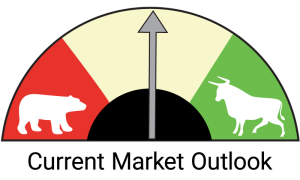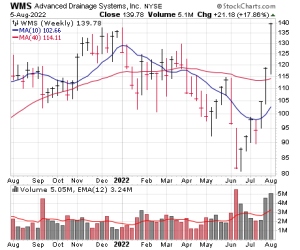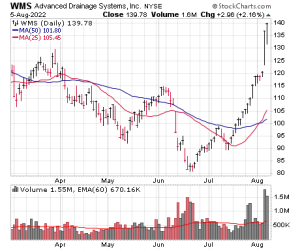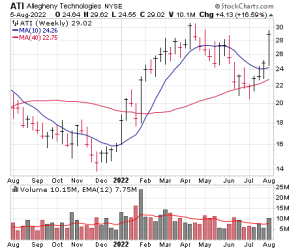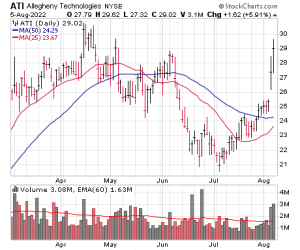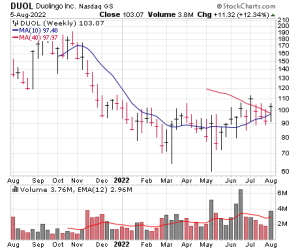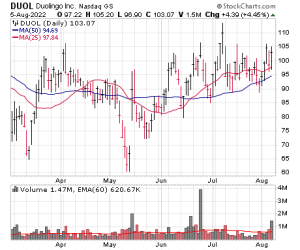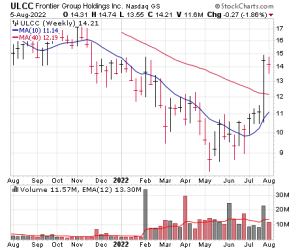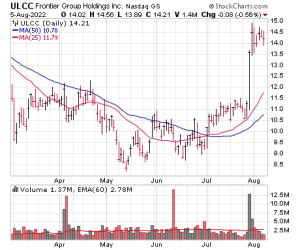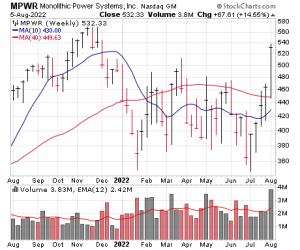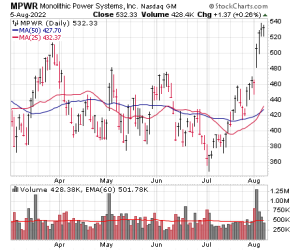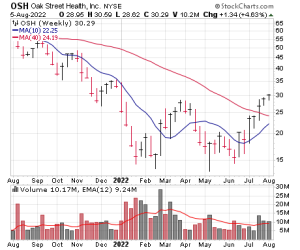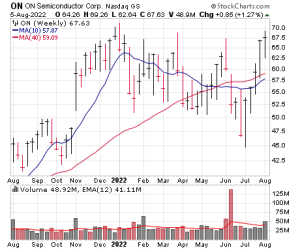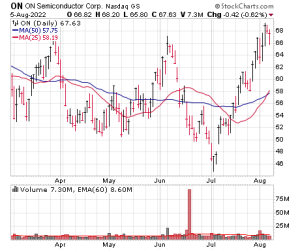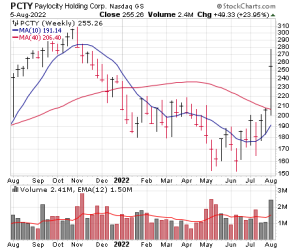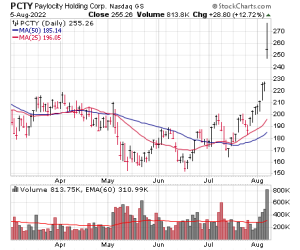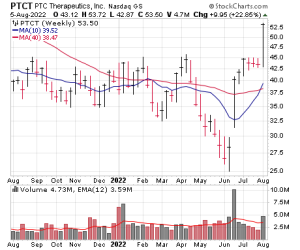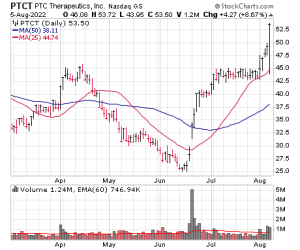Last week was another constructive one in our book, with the market shrugging off some “bad” news and with a few more names beginning to pop above resistance and react well to earnings. Having rallied nicely off the lows, a pullback or consolidation would be relatively normal at this point, the nature of which should be telling--and, of course, if the market simply ignores its short-term “overbought” condition, that would be very encouraging. As for the here and now, the evidence says we’re seeing more good vibes, but there’s still work to be done. We’ll leave our Market Monitor at a level 5 for now.
This week’s list is full of stocks that have shown great power on earnings, which is always good to see. Our Top Pick is helping to lead what looks to be a turnaround in the HCM group.
Cabot Top Ten Trader Issue: August 8, 2022
DOWNLOAD ISSUE PDF
More Good Vibes—but Still Work to be DoneWhile most major indexes didn’t light up the sky, last week was another constructive one in our book, with the market shrugging off some “bad” news (too many jobs created will probably keep the Fed on the warpath) and with a few more names beginning to pop above resistance and react well to earnings. (Mostly shrugging off a warning from Nvidia today was another plus.) Having rallied nicely off the lows, a pullback or consolidation would be relatively normal at this point, the nature of which (huge selling vs. minor weakness, etc.) should be telling--and, of course, if the market simply ignores its short-term “overbought” condition, that would be very encouraging (and possibly even click a blastoff indicator or two). As for the here and now, though, the evidence says we’re seeing more good vibes, but there’s still work to be done as the market tries to transition from bear to bull. We’ll leave our Market Monitor at a level 5 for now.
This week’s list is full of stocks that have shown great power on earnings, which is always good to see. Our Top Pick is Paylocity (PCTY), which is leading what looks to be a turnaround in the HCM group.
| Stock Name | Price | Buy Range | Loss Limit |
| Advanced Drainage Systems (WMS) | 142 | 134-138 | 117-119 |
| ATI Inc. (ATI) | 29 | 27-28.5 | 24.5-25 |
| Duolingo (DUOL) | 96 | 105-107.5 | 94-96 |
| First Solar (FSLR) | 107 | 100-104 | 88-91 |
| Frontier Group (ULCC) | 14 | 13.7-14.5 | 11.8-12.3 |
| Monolithic Power (MPWR) | 536 | 512-532 | 458-473 |
| Oak Street Health (OSH) | 30 | 27.5-29 | 24-25 |
| Onsemi (ON) | 67 | 64-66 | 57-58 |
| Paylocity (PCTY) ★ TOP PICK ★ | 261 | 248-263 | 215-225 |
| PTC Therapeutics (PTCT) | 53 | 48-51 | 40-42 |
Stock 1
Advanced Drainage Systems (WMS)
| Price | Buy Range | Loss Limit |
| 142 | 134-138 | 117-119 |
Why the Strength
One Cabot analyst (who shall remain nameless) took a quick look at this week’s Top Ten list, saw Advanced Drainage at the top and rolled his eyes, thinking this stock (and the list) was going to be chock-full of defensive names. But this company is no stodgy utility—Advanced Drainage is a leader in stormwater (capture, storage and treatment) and onside septic solutions (conveyance and treatment), with various pipes, chambers, basins and (thanks to a recent acquisition) leach-fields and tanks to fit the needs of municipalities, farmers and homeowners. It’s a growth market as most infrastructure is out of date, which results in more flooding and damage, and Advanced’s pipes are made from plastics (half of which is recycled from older products), which means its products are lighter, cheaper to install and yet still have better durability. Pricing has been the main driver of growth in recent quarters (margins are up big), so don’t expect the rapid growth figures of late to continue, but management said volumes picked up throughout the second quarter and into July, and the outlook remains solid: For the full fiscal year (ending next March), the top brass sees sales rising around 20%, EBITDA lifting in the mid 30% range and EBITDA margins rising 3.5 percentage points, while Wall Street sees earnings more than doubling—and those could easily prove conservative given that the latest quarterly report topped expectations by a whopping 50%. As infrastructure spending ramps up, management thinks the next few years should see double digit sales growth and much faster cash flow growth, too. It’s a solid story.
Technical Analysis
WMS had a great, smooth run after the pandemic crash, but it started running out of gas last April, and after one more brief burst up to 140 near year-end, the bottom fell out, with shares suffering three legs down that took the stock down to 80 in June. But what’s happened since is an eye-opener: WMS quickly rallied back to 100, and after a one-week rest, has gone through the roof during the past three weeks, including a booming post-earnings move. The power here is definitely impressive, though we think it’s best to aim for dips and shakeouts to enter.
| Market Cap | $11.8B | EPS $ Annual (Dec) | |
| Forward P/E | 24 | FY 2021 | 2.59 |
| Current P/E | 30 | FY 2022 | 3.15 |
| Annual Revenue | $3.01B | FY 2023e | 5.73 |
| Profit Margin | 20.5% | FY 2024e | 6.40 |
| Qtrly Rev | Qtrly Rev Growth | Qtrly EPS | Qtrly EPS Growth |
| ($M) | (vs. yr-ago-qtr) | ($) | (vs.yr-ago-qtr) |
| Latest qtr | 914 | 37% | 2.22 | 155% |
| One qtr ago | 678 | 53% | 0.54 | 135% |
| Two qtrs ago | 715 | 47% | 0.86 | 39% |
| Three qtrs ago | 707 | 30% | 0.88 | -5% |
Stock 2
ATI Inc. (ATI)
| Price | Buy Range | Loss Limit |
| 29 | 27-28.5 | 24.5-25 |
Why the Strength
A post-pandemic increase in orders for commercial airplanes, along with Western sanctions on Russian companies that supply aerospace metals, is lifting the outlook for Allegheny. The company specializes in producing titanium- and nickel-based alloys, stainless steel and specialty components for the global aerospace and defense markets, including next-generation jet engine components and 3D-printed aerospace products. Last week’s Q2 report drew Wall Street’s attention to the strength in the commercial jet market, prompting a big institution to upgrade the stock (a reason for the strength). Revenue of $960 million handily beat estimates and increased 56% from a year ago, led by strong jet engine sales and operating discipline. Per-share earnings of 54 cents, meanwhile, were nearly 50% above the consensus. By segment, High Performance Materials & Components increased 32% (up 16% from the prior quarter), with sales of commercial jet engine products jumping 90%. In Advanced Alloys & Solutions, sales rose 79% (up 14% sequentially), led by higher energy and chemical market sales. Looking ahead, Allegheny said the ongoing expansion of the commercial aerospace market, coupled with recent actions taken to streamline production and its product portfolio, should allow Allegheny to continue growing nicely despite continued supply-chain and labor-related challenges. Management also said it’s committed to reducing debt and “proactively” returning capital to shareholders, with plans to convert at least 90% of net income to free cash by the end of 2025. Analysts see earnings catapulting higher this year, with another 20%-ish gain in 2023.
Technical Analysis
ATI rode the strength in the defense sector starting in late December 2021, with shares lifting off from 14 and cresting around 31 in mid-April. The stock later slumped due to broad market selling pressures into May and June, eventually finding support at the 40-week line in late June. The rebound wasn’t anything to write home about at the beginning, but earnings have provided a lift—ATI rallied strong both Thursday and Friday (both on big volume) after the report, though the old high provided some resistance today. We’re game for starting a position on further weakness.
| Market Cap | $3.60B | EPS $ Annual (Dec) | |
| Forward P/E | 18 | FY 2020 | -0.52 |
| Current P/E | 22 | FY 2021 | 0.13 |
| Annual Revenue | $3.29B | FY 2022e | 1.58 |
| Profit Margin | 8.0% | FY 2023e | 1.82 |
| Qtrly Rev | Qtrly Rev Growth | Qtrly EPS | Qtrly EPS Growth |
| ($M) | (vs. yr-ago-qtr) | ($) | (vs.yr-ago-qtr) |
| Latest qtr | 960 | 56% | 0.54 | N/A |
| One qtr ago | 834 | 20% | 0.40 | N/A |
| Two qtrs ago | 765 | 16% | 0.25 | N/A |
| Three qtrs ago | 726 | 21% | 0.05 | N/A |
Stock 3
Duolingo (DUOL)
| Price | Buy Range | Loss Limit |
| 96 | 105-107.5 | 94-96 |
Why the Strength
Duolingo looks like the clear leader in a big niche, and its offering is so unique it should stay in the lead. The firm is all about language learning, but there are two big differences between it and some of the competition: The first is that Duolingo uses a freemium model, which gets millions of people in the door using its products for free (ad supported) and allows the firm to upsell them on the paid offering. The second is that the company has made its offering more like a game than a boring class—in fact, an upcoming product enhancement (dubbed Quests) prompts users to accomplish challenges (use the product more) and even buy gems (like an online game; boosting revenue)—the game-like presentation keeps things fresh and boosts engagement. Of course, underlying all of that is a product that works—in fact, Duolingo’s second largest business is its English Test, which is accepted by more than 3,700 higher education programs and the firm is working to expand its reach in the U.S., Canada, the U.K. and Australia. In Q2, revenues lifted 50%, led by a 50% gain in subscription revenue (paid subscribers at quarter-end were 3.3 million, up 71%; subscription revenue made up nearly three quarters of the total), a 24% gain in advertising and a 66% boom in English Test revenue. And while earnings are in the red, free cash flow is positive, coming in at north of 20 cents per share in the quarter. Management is looking for another strong result for Q3 (revenue up in the high 40% range) and, long-term, there’s huge upside here as the firm converts more of its free user base (daily active users were 13.2 million in Q2, up 44% from a year ago; getting a small fraction of them to sign up could dramatically boost the top line) to paid subscribers. Having just 187 funds onboard (at the end of June) isn’t ideal, but we think more big fish will be grabbing shares in the months ahead.
Technical Analysis
DUOL went through the wringer late last year and early this year, but unlike many stocks, it bottomed out a while ago—the bottom building effort began in March when the stock rallied nicely after earnings (four straight weeks of big-volume buying), with another huge round of post-earnings buying in May and a string of five weeks up in a row into July. After three down weeks, DUOL found support on earnings late last week, though it was sloppy today. We like the overall setup, but we’ll set our buy range up from here--a move above 105 in this extremely volatile name should be buyable.
| Market Cap | $4.01B | EPS $ Annual (Dec) | |
| Forward P/E | N/A | FY 2020 | -0.43 |
| Current P/E | N/A | FY 2021 | -1.63 |
| Annual Revenue | $306M | FY 2022e | -1.75 |
| Profit Margin | N/A | FY 2023e | -1.50 |
| Qtrly Rev | Qtrly Rev Growth | Qtrly EPS | Qtrly EPS Growth |
| ($M) | (vs. yr-ago-qtr) | ($) | (vs.yr-ago-qtr) |
| Latest qtr | 88.4 | 50% | -0.38 | N/A |
| One qtr ago | 81.2 | 47% | -0.31 | N/A |
| Two qtrs ago | 73 | 51% | -0.46 | N/A |
| Three qtrs ago | 63.6 | 40% | -0.79 | N/A |
Stock 4
First Solar (FSLR)
| Price | Buy Range | Loss Limit |
| 107 | 100-104 | 88-91 |
Why the Strength
After a tough start to the year, alternative energy stocks are making an impressive comeback after the U.S. Senate passed a $369 billion climate change bill that, if approved by the House, would benefit solar companies. A leader in this space is First Solar, which provides solar panels and utility-scale photovoltaic (PV) solar solutions that use advanced module and system technology. Along with a solid Q2 report, First Solar’s strength is largely due to Wall Street’s recognition that the company would likely be the “biggest beneficiary” (in the words of one institutional analyst) of the clean energy spending bill. First Solar said it would consider expanding its manufacturing operations in the U.S. if the legislation is approved (likely later this week), and the company just received an additional boost when a major bank upgraded the stock. On the financial front, results have historically been choppy due to irregular sales and production: While First Solar’s revenue of $620 million was 1% lower from a year ago, it beat consensus estimates and was a whopping 144% higher from the prior quarter, due mainly to increased module sales. More importantly, the company turned heads by reporting per-share earnings of 52 cents that obliterated estimates of just 4 cents and were miles above the 41-cent loss in Q1. Additionally, the firm’s cash holdings increased to almost $2 billion (up 19% sequentially), thanks to the proceeds from the sale of its Japan project development platform. Management pointed to “agile contracting” as a key reason for the stellar results and expect continued growth, touting strong bookings momentum and a record backlog of over 44 gigawatts that extend future deliveries to 2026, while analysts see the top line rising nearly 30% in Q3 and 26% in 2023.
Technical Analysis
FSLR spent nearly nine months in a funk, peaking last November at 120 and spending most of this year under pressure along with the rest of the solar industry. A key low was hit in late February around 60, a level that would be touched three more times in the ensuing months, each time finding buyers. The final test of this level was last month, and the stock quickly bounced back to the upper 70s—and then went bananas after earnings and the proposal for the green bill, with two massive-volume up days to the century mark and further upside today. We think minor dips are likely but aren’t expecting a big retreat.
| Market Cap | $10.9B | EPS $ Annual (Dec) | |
| Forward P/E | N/A | FY 2020 | 3.73 |
| Current P/E | 56 | FY 2021 | 4.38 |
| Annual Revenue | $2.48B | FY 2022e | -0.19 |
| Profit Margin | 9.0% | FY 2023e | 1.75 |
| Qtrly Rev | Qtrly Rev Growth | Qtrly EPS | Qtrly EPS Growth |
| ($M) | (vs. yr-ago-qtr) | ($) | (vs.yr-ago-qtr) |
| Latest qtr | 621 | -1% | 0.52 | -32% |
| One qtr ago | 367 | -54% | -0.41 | N/A |
| Two qtrs ago | 907 | 49% | 1.23 | 14% |
| Three qtrs ago | 584 | -37% | 0.42 | -71% |
Stock 5
Frontier Group (ULCC)
| Price | Buy Range | Loss Limit |
| 14 | 13.7-14.5 | 11.8-12.3 |
Why the Strength
The airline industry has been getting a ton of bad press in recent months, with flight delays and cancellations making headlines nearly every week. But that bad news is hiding an important fact—after two years when much of the country stayed local, people are traveling like mad and that’s starting to hit the bottom lines of some airlines. Frontier Airlines (as its symbol suggests) is a leading ultra low-cost carrie (114 aircraft, with another 11 being delivered by year-end), and the boom in business is one of the big reasons the stock is strong: In Q2, revenues not only surged 65% from a year ago but where up 43% from Q2 of 2019 (pre-Covid), driven by a 33% gain (over 2019) in ancillary revenue (think checked bags, snacks and drinks) and a 10% hike in capacity (Frontier expanded service in Vegas, Buffalo, Baltimore, Houston, KC, Tampa and elsewhere). And the top brass sees more of that ahead, with Q3 likely to see a similar capacity increase versus 2019 and also increasing load factors (in Q2, 84% of every flight was filled, on average, up a whopping 10 percentage points from the prior quarter). The second reason for the strength is something that didn’t happen—Frontier was outbid for Spirit Airlines by JetBlue, which investors see as a good thing given the rapidly strengthening fundamentals here. (The $25 million fee Spirit will have to pay to Frontier, with another $69 million if JetBlue completes the transaction, is a bonus.) Long term, the firm’s big cost advantages (70% of the industry has higher costs) should lead to continued expansion (Frontier’s order book includes a whopping 244 aircraft). That doesn’t mean Frontier or any airline is a long-term hold, but we think the stock can have a good run going forward.
Technical Analysis
ULCC came public in early 2021 and basically started skidding right away, falling from nearly 23 to a low near 8 in May. The recovery from there was jagged and choppy, but it was the 1-2 punch of earnings and the Spirit breakup that brought in the buyers—ULCC surged above its 200-day line for the first time ever on big volume, and shares have traded tightly (holding all of that gain) in the days since. It’s low priced and can move around, but we’re OK starting a position here or (preferably) on a little weakness.
| Market Cap | $3.10B | EPS $ Annual (Dec) | |
| Forward P/E | N/A | FY 2020 | -1.40 |
| Current P/E | N/A | FY 2021 | -1.39 |
| Annual Revenue | $2.75B | FY 2022e | -1.60 |
| Profit Margin | 2.2% | FY 2023e | 1.37 |
| Qtrly Rev | Qtrly Rev Growth | Qtrly EPS | Qtrly EPS Growth |
| ($M) | (vs. yr-ago-qtr) | ($) | (vs.yr-ago-qtr) |
| Latest qtr | 909 | 65% | 0.09 | N/A |
| One qtr ago | 605 | 123% | -0.50 | N/A |
| Two qtrs ago | 609 | 128% | -0.24 | N/A |
| Three qtrs ago | 630 | 157% | -0.11 | N/A |
Stock 6
Monolithic Power (MPWR)
| Price | Buy Range | Loss Limit |
| 536 | 512-532 | 458-473 |
Why the Strength
The boom in electric vehicles (EVs) and the Industrial Internet of Things (IIoT) are big reasons behind the across-the-board growth of Monolithic Power’s storage and computer chip portfolio. The company provides power circuits used for cloud computing, telecom, automotive and industrial applications, delivering billions of parts annually to some of the world’s largest tech firms. By integrating all necessary components into a single packet, the company’s ultra-compact, space-saving modules boast exceptional power density and high efficiency, as well as some of the lowest failure rates in the chip industry. Revenue of $461 million rose 57% from a year ago in Q2, with per-share earnings of $3.25 up 80% and topping estimates by 31 cents. The blowout results were driven by a 112% increase in storage and computing revenue, which reflected higher commercial notebook and high-end gaming notebook sales. Enterprise data-related sales jumped 118%, thanks to an accelerated ramp in Monolithic’s data center and workstation computing sales. Automotive sales, meanwhile, increased 25% on higher demand for advanced driver systems, digital cockpit and lighting products. The firm’s other segment results were equally strong, including a 29% bump for industrial and a 58% boom for communications sales. What’s more, management expects the good times to continue, guiding for Q3 revenue to come in around $490 million—up 55% at the midpoint if realized and well above what Wall Street was looking for. Analysts do expect growth to slow some going forward (earnings up 13% in 2023), but given the fundamental power in so many areas, we think further upside surprises are in store.
Technical Analysis
After peaking at a record high of 580 in November, MPWR entered 2022 on a downward slide, falling all the way to 350 in late January (down 40%). However, in an impressive sign of relative strength, that was the low—it mostly held above 400 in the months that followed, with the retest in early July shaking out the last of the weak hands. And now we see MPWR acting great, rallying five weeks in a row, including last week’s big-volume move on earnings. Shares are obviously higher priced, but we’re OK buying a few shares here or on minor weakness.
| Market Cap | $24.8B | EPS $ Annual (Dec) | |
| Forward P/E | 42 | FY 2020 | 5.04 |
| Current P/E | 54 | FY 2021 | 7.45 |
| Annual Revenue | $1.50B | FY 2022e | 12.58 |
| Profit Margin | 34.1% | FY 2023e | 14.26 |
| Qtrly Rev | Qtrly Rev Growth | Qtrly EPS | Qtrly EPS Growth |
| ($M) | (vs. yr-ago-qtr) | ($) | (vs.yr-ago-qtr) |
| Latest qtr | 461 | 57% | 3.25 | 80% |
| One qtr ago | 378 | 48% | 2.45 | 68% |
| Two qtrs ago | 337 | 44% | 2.12 | 62% |
| Three qtrs ago | 324 | 25% | 2.06 | 22% |
Stock 7
Oak Street Health (OSH)
| Price | Buy Range | Loss Limit |
| 30 | 27.5-29 | 24-25 |
Why the Strength
Oak Street Health operates primary care facilities for adults on Medicare living in areas that have more than 50,000 eligible patients that have incomes below 300% of the poverty line, an underserved segment. Oak Street contracts with governments to care for patients in return for a percentage of their monthly premium, adjusted on a per-case basis for health and case complexity. That reduces costs for the government and allows Oak Street to keep any profit it generates. The company’s strategy is to keep patients happy and healthy, reckoning that an emphasis on preventative care at its 144 owned and operated centers reduces very costly hospital visits. A typical patient has lots of needs, with the average Oak Street resident on seven or more medications and the vast majority suffering a chronic condition. About 60% of Medicare’s money is usually spent on hospitalizations and just 3% on primary care; Oak Street spends about 9% of its patient capital on primary care and estimates a 51% reduction in hospitalizations as a result. Caring for aging Americans is a growth business, with a universe of some 30 million Medicare recipients which could support 10,000 centers in theory. The company is opening new locations at a fast pace – it’ll add some 15 centers this quarter – and feels its standardized model of centers with lots of common space and an emphasis on team care will allow it to grow much larger. Oak Street, founded in 2012, is investing a lot into its business, so will likely post a net loss of $2.29 per share this year while seeing sales rise almost 50% to $2.14 billion. Losses are widening this year on pandemic hospitalizations, but a return to a trend of narrowing losses should return in 2023. It’s an interesting story.
Technical Analysis
OSH went over the falls with everything else starting late last year, finally finding some support in the 14 area in March. The rally from there didn’t stick, but the retest of the 13-14 area in May and June did hold and now the stock has changed character—OSH is up five weeks in a row, the last three on above-average volume, with the recent quarterly report (released August 2) helping the cause. Given the recent move and the fact the stock is a bit thin, we suggest buying on weakness.
| Market Cap | $7.31B | EPS $ Annual (Dec) | |
| Forward P/E | N/A | FY 2020 | -0.72 |
| Current P/E | N/A | FY 2021 | -1.84 |
| Annual Revenue | $1.82B | FY 2022e | -2.25 |
| Profit Margin | N/A | FY 2023e | -1.61 |
| Qtrly Rev | Qtrly Rev Growth | Qtrly EPS | Qtrly EPS Growth |
| ($M) | (vs. yr-ago-qtr) | ($) | (vs.yr-ago-qtr) |
| Latest qtr | 524 | 48% | -0.66 | N/A |
| One qtr ago | 514 | 73% | -0.43 | N/A |
| Two qtrs ago | 394 | 58% | -0.62 | N/A |
| Three qtrs ago | 389 | 78% | -0.49 | N/A |
Stock 8
Onsemi (ON)
| Price | Buy Range | Loss Limit |
| 67 | 64-66 | 57-58 |
Why the Strength
Onsemi is a chip maker that is pivoting away from producing lots of commodity-like silicon chips into the higher value market for silicon carbide (SiC). SiC is much better at handling the extreme heat chips experience in high voltage (and fast growing) applications such as in EVs and chargers. SiC is a small market now, probably $3 billion total worldwide, but is growing very fast. Onsemi has long been a top-10 chip provider to automakers, offering some 10,000 offerings, but the market position has often come with a price – shares tended to be boom and bust on the health of the overall semiconductor market. The outlook for traditional silicon is mixed these days, with sales essentially flat in what Onsemi considers a couple of non-core areas it’s looking to exit. But strength in its two primary markets, automotive and industrial applications (think renewable energy and grid management) helped power overall sales growth of 25% in its latest quarter, to $2 billion, with net income of $1.34 a share (more than double that of a year ago). For the rest of the year, Onsemi is focusing on completing its transition out of lower margin areas to get the overall business to its target gross margin of 48% to 50%. About $600 million of recent quarter sales are in areas the company wants to exit, and until those are jettisoned, sales growth and margins may be held back. Come 2023, management expects to be exclusively in automotive and industrial, providing both silicon and SiC chips. By then it also will have completed the acquisition and upgrading of a New York foundry to make 300-millimeter SiC, the most in-demand form factor. For the year, look for sales of $8 billion and EPS over $5, meaning shares look well priced at 13 times 2022 sales, though to be fair, 2023 could be a transition year.
Technical Analysis
ON peaked in January and thrashed around for a few months between 50 and 70 before nosediving to 45 in early July as the chip sector gave up the ghost. But that looks like the final shakeout—ON has shown excellent action since then, rallying five weeks in a row back to its highs, including a decent post-earnings reaction late last week. Like most things, shares are hitting a little resistance here, so we’re OK aiming for dips of a point or two.
| Market Cap | $29.3B | EPS $ Annual (Dec) | |
| Forward P/E | 13 | FY 2020 | 0.85 |
| Current P/E | 15 | FY 2021 | 2.95 |
| Annual Revenue | $7.63B | FY 2022e | 5.12 |
| Profit Margin | 28.3% | FY 2023e | 4.93 |
| Qtrly Rev | Qtrly Rev Growth | Qtrly EPS | Qtrly EPS Growth |
| ($M) | (vs. yr-ago-qtr) | ($) | (vs.yr-ago-qtr) |
| Latest qtr | 2.09 | 25% | 1.34 | 113% |
| One qtr ago | 1.95 | 31% | 1.22 | 249% |
| Two qtrs ago | 1.85 | 28% | 1.09 | 211% |
| Three qtrs ago | 1.74 | 32% | 0.87 | 222% |
Stock 9
Paylocity (PCTY) ★ TOP PICK ★
| Price | Buy Range | Loss Limit |
| 261 | 248-263 | 215-225 |
Why the Strength
With the work-from-home trend still going strong, human capital management (HCM) has become more critical than ever for many companies. Paylocity eases this burden by providing a variety of cloud-based services for enterprises, including payroll and expense management, tax service, recruiting and employee management software. The company focuses on smaller firms, and its products are geared for all aspects of the HCM process. The stock is strong today because, simply put, business is good and getting stronger: In last week’s fiscal Q4 report, revenues of $229 million popped a big 37% from a year ago, the fastest rate of growth in at least a couple of years, while earnings of 80 cents were a huge 27 cents above expectations. Recurring revenue grew 34% during the entire fiscal year, to $848 million as the company’s HCM software offerings continued to resonate with customers. Paylocity said all of its products have seen “significant” increases in utilization, including in community usage, where monthly users grew by more than 40% and video creation increased by over 80% in fiscal 2022. Paylocity ended the fiscal year with a total base of over 33,000 clients, a 16% increase from a year ago, aided by “very high” client satisfaction as revenue retention remained greater than 92%—the highest level in several years. Going forward, management guided for the fiscal Q1 (the current quarter) top line to reach $239 million at the midpoint, which would be a 32% increase, while full-year revenue is expected to grow 28% to just over $1 billion. Paylocity sees itself entering 2023 against a backdrop of a “very large and addressable market” with plans to continue scaling its business. This is a solid, consistent growth story that should keep playing out for a long time to come.
Technical Analysis
Cloud stocks like PCTY fell out of favor late last year after the boom times they experienced during the pandemic. From a record high of 315 last November, the stock spent the next seven-and-a-half months mostly trending lower, albeit with a couple of bottoming attempts along the way. The nadir was finally reached in mid-June, when shares hit 152 and sharply reversed, recovering to 200 by early July. But the real action happened last week, with four straight big-volume buying days, capped by Friday’s earnings-induced gap. There’s still overhead to chew through, but we’re OK starting small here or on a normal pullback.
| Market Cap | $14.3B | EPS $ Annual (Jun) | |
| Forward P/E | 79 | FY 2021 | 2.11 |
| Current P/E | 70 | FY 2022 | 3.25 |
| Annual Revenue | $853M | FY 2023e | 3.23 |
| Profit Margin | 19.8% | FY 2024e | 3.95 |
| Qtrly Rev | Qtrly Rev Growth | Qtrly EPS | Qtrly EPS Growth |
| ($M) | (vs. yr-ago-qtr) | ($) | (vs.yr-ago-qtr) |
| Latest qtr | 229 | 37% | 0.80 | 74% |
| One qtr ago | 246 | 32% | 1.22 | 39% |
| Two qtrs ago | 196 | 34% | 0.64 | 64% |
| Three qtrs ago | 182 | 34% | 0.59 | 55% |
Stock 10
PTC Therapeutics (PTCT)
| Price | Buy Range | Loss Limit |
| 53 | 48-51 | 40-42 |
Why the Strength
Promising clinical results from a drug for patients with a rare genetic disease has garnered lots of attention for PTC Therapeutics (covered in the July 11 report). The company, which develops orally administered small molecule drugs and gene therapies for rare diseases like Duchene muscular dystrophy (DMD), already has five approved treatments in its pipeline. But it’s the firm’s DMD drug Translarna that’s causing most of the excitement. While per-share earnings were in the red and missed estimates, PTC reported 42% growth in its Q2 top line, led by strength in its DMD franchise, with product revenue of $134 million (up 32%). Translarna net product sales increased 46%, to $77 million, with growth coming from new patients across an expanding geographic outreach. Other highlights in the second quarter include 16% sales growth for the pediatric DMD drug, Emflaza, and an FDA label extension approval for the spinal muscular dystrophy (SMA) drug, Evrysdi, to include infants under two months old with SMA. In another big regulatory win for the company, the European Commission approved Upstaza, PTC’s gene therapy for patients with an ultra-rare amino acid deficiency. Management expressed confidence that the rest of the year would see elevated sales, guiding for full-year revenue of around $725 million (up 34% from a year ago) and net product revenue for the DMD franchise around $485 million (15% higher than last year). The firm also touted its “broad and deep” pipeline across a range of diseases and expects key results for several registration-directed studies during the next six to twelve months, which it believes will continue the “transformational growth.” Analysts see sales 35%-ish sales for 2022 and another decent uptick in 2023.
Technical Analysis
After getting shaken up along with the broad market in April and May, PTCT plunged to new lows in mid-June, but as we wrote previously, that dip proved to be the last big shakeout, with shares snapping right back to 45—and then, very encouragingly, shares tightened up, a sign of accumulation. And now PTCT is following through to the upside after earnings and also thanks to some M&A activity in the sector. After Friday’s wild action, we advise aiming for pullbacks if you want in.
| Market Cap | $3.80B | EPS $ Annual (Sep) | |
| Forward P/E | N/A | FY 2020 | -6.64 |
| Current P/E | N/A | FY 2021 | -7.43 |
| Annual Revenue | $619M | FY 2022e | -5.27 |
| Profit Margin | N/A | FY 2023e | -3.86 |
| Qtrly Rev | Qtrly Rev Growth | Qtrly EPS | Qtrly EPS Growth |
| ($M) | (vs. yr-ago-qtr) | ($) | (vs.yr-ago-qtr) |
| Latest qtr | 166 | 42% | -2.13 | N/A |
| One qtr ago | 149 | 26% | -1.78 | N/A |
| Two qtrs ago | 165 | 39% | -2.03 | N/A |
| Three qtrs ago | 139 | 17% | -1.89 | N/A |
Previously Recommended Stocks
Below you’ll find Cabot Top Ten Trader recommended stocks. Those rated HOLD are stocks that traded within our suggested buy range within two weeks of appearing in the Top Ten and still look good; hold if you own them. Stocks rated WAIT have yet to dip into our suggested buy range … but can be bought if they do so within the next week.
Those stocks rated SELL should be sold if you own them; they will no longer be listed here. Finally, Stocks in the DROPPED category are those that failed to trade within our buy range within two weeks of our recommendation; that’s not a bad thing, we just never got the price we wanted. Please use this list to keep up with our latest thinking, and don’t hesitate to call or email us with any questions you may have. New recommendations each week are in bold.
| Date | Stock | Symbol | Top Pick | Original Buy Range | Price as of 8/8/2022 |
| HOLD |
| 7/18/22 | Acadia Health | ACHC | ★ | 73-76 | 81 |
| 7/11/22 | Agilon Health | AGL | ★ | 24-25.5 | 27 |
| 7/5/22 | Alliance Resource Ptnr | ARLP | | 17.3-18.3 | 22 |
| 8/1/22 | Analog Devices | ADI | | 167-172 | 176 |
| 6/21/22 | Argenx | ARGX | | 345-355 | 367 |
| 7/18/22 | Axonics | AXNX | | 60-62 | 71 |
| 7/18/22 | Axsome Therepeutics | AXSM | | 38.5-40.5 | 43 |
| 6/27/22 | Biomarin Pharm | BMRN | | 83-86 | 96 |
| 5/23/22 | Bumble | BMBL | | 25.5-27.5 | 37 |
| 8/1/22 | Cadence Design | CDNS | ★ | 178-183 | 184 |
| 5/16/22 | Celsius | CELH | | 53-56 | 101 |
| 7/18/22 | Consol Energy | CEIX | | 53.5-56.5 | 60 |
| 7/25/22 | Chesapeake Energy | CHK | | 89-92 | 93 |
| 7/18/22 | Chewy | CHWY | | 39.5-42 | 48 |
| 8/1/22 | CH Robinson | CHRW | | 107-110 | 111 |
| 8/1/22 | Chart Industries | GTLS | | 187-193 | 203 |
| 7/18/22 | Crisper Therapeutics | CRSP | | 75.5-78.5 | 81 |
| 6/21/22 | CrowdStrike | CRWD | | 161-168 | 190 |
| 7/18/22 | Day One Pharma | DAWN | | 16-17.5 | 24 |
| 5/10/21 | Devon Energy | DVN | ★ | 25-26.5 | 58 |
| 6/6/22 | Enphase Energy | ENPH | | 197-205 | 288 |
| 8/1/22 | EQT Corp. | EQT | | 40.5-43 | 41 |
| 7/25/22 | Gitlab | GTLB | ★ | 53.5-56 | 67 |
| 4/18/22 | Halozyme | HALO | | 40.5-42 | 45 |
| 5/16/22 | Intra-Cellular Therapies | ITCI | | 54-57 | 59 |
| 7/18/22 | Lantheus | LNTH | | 65-67.5 | 79 |
| 7/25/22 | Lattice Semi | LSCC | | 54.5-56 | 64 |
| 7/25/22 | Levi Strauss | LEVI | | 18.0-18.8 | 19 |
| 5/23/22 | Nexstar Media | NXST | | 173-178 | 196 |
| 6/13/22 | Neurocrine Bio | NBIX | | 89-92 | 105 |
| 6/21/22 | Ollie’s Bargain Outlet | OLLI | | 56-58.5 | 64 |
| 8/1/22 | Petrobras | PBR | | 13.5-14 | 15 |
| 7/11/22 | PTC Therapeutics | PTCT | | 41-43 | 53 |
| 7/25/22 | Qualcomm | QCOM | | 147-153 | 148 |
| 6/13/22 | Scorpio Tankers | STNG | | 31-33 | 40 |
| 8/1/22 | Shoals | SHLS | | 21-22.5 | 24 |
| 6/27/22 | Shockwave Medical | SWAV | | 185-195 | 222 |
| 7/11/22 | Vertex Pharmaceuticals | VRTX | | 288-296 | 294 |
| 8/1/22 | WillScot | WSC | | 37-38.5 | 41 |
| 8/1/22 | WW Grainger | GWW | | 530-550 | 562 |
| 7/11/22 | Zoom Communications | ZM | | 105-109 | 115 |
| WAIT |
| None this week | | | | | |
| SELL RECOMMENDATIONS |
| 7/11/22 | Braze | BRZE | | 40-42 | 49 |
| 7/25/22 | Cinemark | CNK | | 18.5-19.3 | 17 |
| 7/11/22 | Fortinet | FTNT | | 59-61 | 53 |
| 7/25/22 | Global Blood Ther | GBT | | 32-34 | 67 |
| 7/25/22 | Incyte Corp. | INCY | | 78-80 | 74 |
| 7/11/22 | Karuna Therapeutics | KRTX | | 127-131 | 241 |
| 7/5/22 | Perrigo | PRGO | | 39.5-41 | 43 |
| 6/27/22 | Royalty Pharma | RPRX | ★ | 41.5-43.5 | 43 |
| 5/31/22 | United Therapeutics | UTHR | ★ | 224-230 | 219 |
| DROPPED |
| 7/25/22 | Quanta Services | PWR | | 127-131 | 137 |
| 7/25/22 | Repligen | RGEN | | 189-194 | 250 |
The next Cabot Top Ten Trader issue will be published on August 15, 2022.
About the Analyst
Mike Cintolo
A growth stock and market timing expert, Michael Cintolo is Chief Analyst of Cabot Growth Investor and Cabot Top Ten Trader. Since joining Cabot in 1999, Mike has uncovered exceptional growth stocks and helped to create new tools and rules for buying and selling stocks. Perhaps most notable is his development of the proprietary trend-following market timing system, Cabot Tides, which has helped Cabot place among the top handful of market-timing newsletters numerous times.

